
Characterization of positioning uncertainties in PET‐CT‐MR trimodality solutions for radiotherapy
Sign Up to like & getrecommendations! Published in 2022 at "Journal of Applied Clinical Medical Physics"
DOI: 10.1002/acm2.13617
Abstract: Abstract The purpose of this study was to evaluate the positioning uncertainties of two PET/CT‐MR imaging setups, C1 and C2. Because the PET/CT data were acquired on the same hybrid device with automatic image registration,… read more here.
Keywords: uncertainties pet; pet trimodality; registration; characterization positioning ... See more keywords

Constrained spherical deconvolution of nonspherically sampled diffusion MRI data
Sign Up to like & getrecommendations! Published in 2020 at "Human Brain Mapping"
DOI: 10.1002/hbm.25241
Abstract: Constrained spherical deconvolution (CSD) of diffusion‐weighted MRI (DW‐MRI) is a popular analysis method that extracts the full white matter (WM) fiber orientation density function (fODF) in the living human brain, noninvasively. It assumes that the… read more here.
Keywords: constrained spherical; tissue; tissue densities; mri ... See more keywords

Restoring statistical validity in group analyses of motion‐corrupted MRI data
Sign Up to like & getrecommendations! Published in 2022 at "Human Brain Mapping"
DOI: 10.1002/hbm.25767
Abstract: Motion during the acquisition of magnetic resonance imaging (MRI) data degrades image quality, hindering our capacity to characterise disease in patient populations. Quality control procedures allow the exclusion of the most affected images from analysis.… read more here.
Keywords: mri data; motion; image quality; restoring statistical ... See more keywords

3D printing from MRI Data: Harnessing strengths and minimizing weaknesses
Sign Up to like & getrecommendations! Published in 2017 at "Journal of Magnetic Resonance Imaging"
DOI: 10.1002/jmri.25526
Abstract: 3D printing facilitates the creation of accurate physical models of patient‐specific anatomy from medical imaging datasets. While the majority of models to date are created from computed tomography (CT) data, there is increasing interest in… read more here.
Keywords: printing mri; weaknesses printing; data harnessing; harnessing strengths ... See more keywords

VTDCE-Net: A time invariant deep neural network for direct estimation of pharmacokinetic parameters from undersampled DCE MRI data.
Sign Up to like & getrecommendations! Published in 2022 at "Medical physics"
DOI: 10.1002/mp.16081
Abstract: PURPOSE To propose a robust time and space invariant deep learning method to directly estimate the pharmacokinetic/tracer kinetic (PK/TK) parameters from undersampled dynamic contrast-enhanced (DCE) Magnetic Resonance Imaging (MRI) data. METHODS DCE-MRI consists of 4D (3D-spatial… read more here.
Keywords: time; invariant deep; parameters undersampled; vtdce net ... See more keywords

Automation of pattern recognition analysis of dynamic contrast‐enhanced MRI data to characterize intratumoral vascular heterogeneity
Sign Up to like & getrecommendations! Published in 2018 at "Magnetic Resonance in Medicine"
DOI: 10.1002/mrm.26822
Abstract: To automate dynamic contrast‐enhanced MRI (DCE‐MRI) data analysis by unsupervised pattern recognition (PR) to enable spatial mapping of intratumoral vascular heterogeneity. read more here.
Keywords: pattern recognition; enhanced mri; dynamic contrast; contrast enhanced ... See more keywords

Multivariate functional mixed model with MRI data: An application to Alzheimer's disease
Sign Up to like & getrecommendations! Published in 2023 at "Statistics in Medicine"
DOI: 10.1002/sim.9683
Abstract: Alzheimer's Disease (AD) is the leading cause of dementia and impairment in various domains. Recent AD studies, (ie, Alzheimer's Disease Neuroimaging Initiative (ADNI) study), collect multimodal data, including longitudinal neurological assessments and magnetic resonance imaging… read more here.
Keywords: multivariate functional; alzheimer disease; mri; model ... See more keywords

Using hierarchical unsupervised learning to integrate and reduce multi-level and multi-paraspinal muscle MRI data in relation to low back pain
Sign Up to like & getrecommendations! Published in 2022 at "European Spine Journal"
DOI: 10.1007/s00586-022-07169-z
Abstract: The paraspinal muscles (PSM) are a key feature potentially related to low back pain (LBP), and their structure and composition can be quantified using MRI. Most commonly, quantifying PSM measures across individual muscles and individual… read more here.
Keywords: mri data; psm; low back; pain ... See more keywords

Pattern recognition and pharmacokinetic methods on DCE-MRI data for tumor hypoxia mapping in sarcoma
Sign Up to like & getrecommendations! Published in 2017 at "Multimedia Tools and Applications"
DOI: 10.1007/s11042-017-5046-6
Abstract: The main purpose of this study is to analyze the intrinsic tumor physiologic characteristics in patients with sarcoma through model-free analysis of dynamic contrast enhanced MR imaging data (DCE-MRI). Clinical data were collected from three… read more here.
Keywords: pattern recognition; dce mri; pharmacokinetic methods; recognition pharmacokinetic ... See more keywords

The reliability of a deep learning model in clinical out-of-distribution MRI data: a multicohort study
Sign Up to like & getrecommendations! Published in 2020 at "Medical image analysis"
DOI: 10.1016/j.media.2020.101714
Abstract: Deep learning (DL) methods have in recent years yielded impressive results in medical imaging, with the potential to function as clinical aid to radiologists. However, DL models in medical imaging are often trained on public… read more here.
Keywords: deep learning; study; model; mri data ... See more keywords

The prognostic reliability of intracranial pressure monitoring and MRI data in severe traumatic brain injury.
Sign Up to like & getrecommendations! Published in 2017 at "Magnetic resonance imaging"
DOI: 10.1016/j.mri.2016.10.033
Abstract: OBJECTIVE The predictive quality of intracranial pressure (ICP) monitoring has for many years been a matter of debate. We correlate ICP data comparing MRI data with the outcome after severe traumatic brain injury to evaluate… read more here.
Keywords: traumatic brain; severe traumatic; intracranial pressure; mri data ... See more keywords